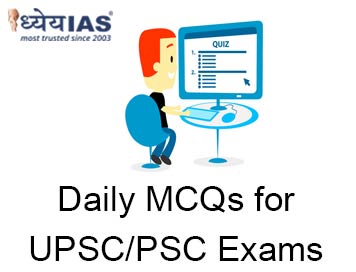Home > Daily-mcqs
Daily-mcqs 22 Apr 2025

Q1:
Consider the following statements regarding the CROP assessment for Rabi 2024–25: How many of the above statements are correct?
A: Only one
B: Only two
C: All three
D: None
Answer: D
Explanation:
Statements 1 and 3 are incorrect. The CROP framework was implemented across eight major wheat-producing states and estimated wheat sowing at 330.8 lakh hectares, which closely matched the government’s data. Statement 2 is incorrect because CROP integrates both optical and SAR (Synthetic Aperture Radar) satellite data (e.g., EOS-04, EOS-06, Resourcesat-2A), not just optical data. This multi-source integration enables continuous monitoring even under cloudy conditions, making the process more robust and reliable.
Q2:
Which of the following best explains the significance of the aqueous recycling method for Perovskite Solar Cells?
A: It reduces the cost of silicon-based solar panels.
B: It increases solar cell efficiency beyond 40%.
C: It enables safe recovery of perovskite materials without toxic solvents.
D: It eliminates the need for any chemical processing in solar technology.
Answer: C
Explanation:
The water-based method for recycling PSCs is significant because it avoids toxic solvents like dimethylformamide, addressing key safety and environmental concerns. It allows recovery of valuable perovskite materials—including lead—in a safer, eco-friendly manner, thereby advancing circular economy goals. While the process doesn't increase efficiency beyond current records or eliminate chemical processing entirely, it does preserve material quality over multiple recycling rounds and minimizes waste, making it a breakthrough in sustainable solar technology.
Q3:
Consider the following statements: Statement–I: The Gandhi Sagar relocation represents a milestone for India’s cheetah reintroduction efforts. Which of the following is correct?
Statement II: Gandhi Sagar Wildlife Sanctuary has an abundant population of blackbuck, nilgai, and chital, exceeding the minimum prey density required for cheetahs.
A: Both Statement–I and Statement–II are correct, and Statement–II is the correct explanation for Statement–I.
B: Both Statement–I and Statement–II are correct, but Statement–II is not the correct explanation for Statement–I.
C: Statement–I is correct, but Statement–II is incorrect.
D: Statement–I is incorrect, but Statement–II is correct.
Answer: C
Explanation:
Statement–I is correct: Relocation of Prabhash and Pavak marks a major step under Project Cheetah, expanding the conservation experiment beyond Kuno. Statement–II is incorrect. Although Gandhi Sagar houses chital, nilgai, and blackbuck, the sanctuary lacks the required prey density for sustaining cheetahs. Only 475 prey animals are currently present, far short of the minimum 1,560 required annually. Hence, the move is significant but not based on existing prey abundance, making Statement–II false.
Q4:
Why are curlews considered keystone species in their ecosystems?
A: They are apex predators that regulate prey population.
B: Their extinction would collapse the insect population.
C: Their presence supports wetland health and multiple species.
D: They are indicators of tree cover and forest density.
Answer: C
Explanation:
Curlews are keystone species because they help sustain wetland health through their feeding behavior and ecological interactions. Their long, sensitive beaks probe soil for invertebrates, helping maintain soil health and species balance in wetland habitats. Their decline can disrupt entire food chains, indicating deeper ecosystem instability. They are not apex predators nor direct forest indicators, and their role doesn’t focus solely on insect population control. Hence, the best explanation for their ecological significance is option (c).
Q5:
Consider the following statements regarding anemia and its relation to air pollution: Which one of the following is correct?
Statement 1: Exposure to PM 2.5 increases hepcidin production in the liver, thereby inhibiting iron absorption.
Statement 2: Hepcidin suppression improves red blood cell production in the bone marrow.
A: Statement 1 is correct, and Statement 2 is incorrect
B: Statement 1 is incorrect, and Statement 2 is correct
C: Both Statement 1 and 2 are correct, and Statement 2 is the explanation of Statement 1
D: Both Statement 1 and 2 are incorrect
Answer: A
Explanation:
Statement 1 is correct: PM 2.5 triggers cytokine release, raising hepcidin levels in the liver, which blocks iron absorption. However, Statement 2 is incorrect because hepcidin, not its suppression, is linked with reduced red blood cell production. In fact, increased hepcidin inhibits iron availability, suppressing bone marrow activity. Hence, only Statement 1 is correct, and the cause-effect logic presented in Statement 2 is flawed.